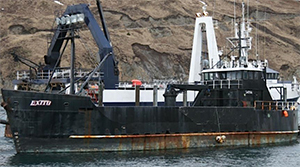Barely two hours after leaving Dutch Harbor, Alaska, for nearby Akutan Island, the uninspected freighter Exito began listing to starboard. The captain slowed and made plans to turn around, but the vessel never made it back.
Over 45 minutes, the list got worse until Exito suddenly went under. Three people on board escaped to a life raft, but two others — contractors riding to Trident Seafoods’ Akutan fish processing plant — never made it off the boat. The 117-foot vessel sank roughly four miles from Unalaska Island in the Aleutian chain.
The National Transportation Safety Board (NTSB) determined progressive flooding caused the sinking on Dec. 6, 2016. The agency suggested holes in the steel decking covered by wood were a potential source of flooding, although the exact source was never identified. Investigators also said the three contractors on board weren’t prepared or equipped for an emergency during the seven-hour voyage.
Trident Seafoods chartered Exito to carry crab waste and stickwater — a byproduct from making fish meal — from its Akutan plant. The ship also carried cargo between Dutch Harbor and the facility about 40 miles away by boat.
During its final voyage, Exito carried 12 55-gallon drums of antifreeze and air filters stacked on pallets, as well as tools and other equipment. The cargo, estimated at 10,000 pounds, was secured with ropes and chains.
The captain told investigators that seas increased to 10 feet after Exito left Unalaska Bay. Shortly after 2100, the ship developed a starboard list of 2 or 3 degrees and no longer righted itself in the swell. Cargo began shifting on deck, and at 2122 he called the vessel’s owner and said he was returning to Dutch Harbor.
“Something doesn’t feel right,” the captain said, according to the NTSB report.
He activated the pumps just before several waves crashed over the starboard rail, leaving the deck awash. Sensing trouble, the captain sounded the general alarm and told the contractors to put on their immersion suits. He made a VHF distress call and reported the situation to the shipowner by cellphone.
The captain checked on the contractors and found only one wearing an immersion suit. One contractor could not fully zip his suit, and the third man had an even harder time. With help, that man — described as “large in size” — got the suit zipped to midchest.
By this point the ship was listing 7 to 10 degrees, the report said. The third contractor refused to follow the captain to the wheelhouse, so the captain resorted to dragging the man to the stairwell. Later, the captain said the man looked like he’d given up.
 |
|
Pat Rossi illustration |
The captain and the first contractor, whose immersion suit was fully on, tried to get the second contractor out the port wheelhouse exit. He refused. “Each time they tried to push him out,” the report said, “the second contractor reportedly braced himself with his hands at the doorway.”
Exito’s captain made a final VHF distress call citing the vessel’s location, then helped the deck hand launch the life raft. The captain looked back and saw the second contractor at the top of the stairs, and the third contractor at the landing on deck two. The ship sank as the captain returned to the wheelhouse to help the two men.
The deck hand later told investigators “the boat went out from underneath my feet.” He swam to the life raft alongside the captain and the first contractor. The fishing vessel Afognak Strait rescued them about an hour after the sinking. Afognak Strait and another fishing boat that responded, Commitment, stayed in the area throughout the night looking for survivors.
NTSB investigators identified several safety lapses. Before leaving Dutch Harbor, Exito’s captain held a safety briefing that outlined where the immersion suits were located. However, the contractors never tried them on to make sure they fit.
The briefing also included a demonstration on emergency procedures, including protocols if the general alarm is activated. In that scenario, the captain said the men should put on their suits and come to the wheelhouse, the report said. But he did not describe other potential safe exits. Exit signage on Exito was mostly missing.
The U.S. Coast Guard never heard the captain’s VHF distress calls, which is not uncommon in remote parts of Alaska. The NTSB determined that the limitations of VHF in the area “are not widely known,” even among many mariners who work in those waters. The agency suggested that crews have alternate ways of communicating during emergencies.
In this case, Exito’s owner, Aleutian Endeavor LLC, contacted the Coast Guard after speaking with the captain the final time. The Coast Guard also registered the EPIRB when it activated at about 2145.
Exito was built in 1956 as an oil field service vessel but later underwent a conversion for use as a crab fishing boat. As of 2004, Exito was barred from performing any fisheries work — including hauling stickwater — under a conservation agreement that removed it from the crab fleet. Yet as a freighter hauling fish byproducts, it should have been required to have a load line certificate. Investigators also learned the vessel hadn’t been inspected since 2013.
Exito was never salvaged, so the source of flooding was not determined. However, the captain told investigators a starboard forward void wasn’t completely watertight. A previous captain used epoxy to plug a leak believed to be coming from a stickwater tank but never sought a permanent fix.
“While it cannot be determined if the source of the list was from water intrusion in the starboard-side void, it was a known issue for the owner and captain, and there were no measures taken to appropriately correct it,” the report said.

